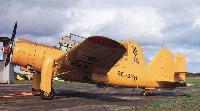Фотографии
-
Регистрационный номер: SE-BRA, SE-BYD [2] The first Swedish Firefly TT.1, SE-BRA, alongside SE-BYD during regular maintenance. Designed by Herbert “Charlie” Chaplin, the Firefly had been developed in line with the Fleet Air Arm’s firmly-established belief in the efficacy of a fast two-seat aircraft that combined the fighter and reconnaissance roles, as had its predecessor, Fairey’s Rolls-Royce Merlin-engined Fulmar.
Самолёты на фотографии: Fairey Firefly - Великобритания - 1941
-
Регистрационный номер: SE-BYD [2] A rare colour air-to-air study of Firefly TT.1 SE-BYD (formerly MB702 in Fleet Air Arm service) low over a misty sea. Note the wing-mounted fuel tanks - originally devised for use on Hawker Sea Hurricanes - which were a standard fit for target-towing operations, as well as the apparatus fitted to the tailplane to avoid tangled cables.
Самолёты на фотографии: Fairey Firefly - Великобритания - 1941
-
Регистрационный номер: SE-BRC, SE-BRO Firefly SE-BRC (formerly Z1908 in Fleet Air Arm service) at a Swedish airfield in the 1950s, with Saab B 17 SE-BRO in the background. Although the Firefly had a more powerful engine than the Saab, the former was more trouble-prone, the Saab’s air-cooled radial proving to be rugged and easy to maintain.
Самолёты на фотографии: Fairey Firefly - Великобритания - 1941SAAB B17 - Швеция - 1940
-
At least one of the Swedish Fireflies featured nose art, this example showing a cartoon firefly riding a sausage-like BT 13 target indicator; The word radarkorv, translated literally, means “radar sausage”!
Самолёты на фотографии: Fairey Firefly - Великобритания - 1941
-
Four of the Swedish Fireflies, the nearest being one of three acquired from the Royal Danish Air Force, in whose colours it is still painted, in 1959. It was subsequently given the Swedish civil registration SE-CHM.
Самолёты на фотографии: Fairey Firefly - Великобритания - 1941
-
Регистрационный номер: SE-CAU With a typically wintry backdrop Firefly SE-CAU (formerly PP469) awaits another sortie. Following its retirement in 1964 this example was used for firefighting training at Midlanda (now Sundsvall-Harnosand Airport). Its fuselage and centre section are now in Holland, at the Aviodrome Museum in Lelystad, awaiting restoration.
Самолёты на фотографии: Fairey Firefly - Великобритания - 1941
-
Регистрационный номер: SE-CAW You never know until you try it! - Firefly SE-CAW is towed along the ice of the Stockholm archipelago after its belly-landing in February 1963. It was repaired and returned to service and is currently on loan to the Royal Danish Air Force Museum.
Самолёты на фотографии: Fairey Firefly - Великобритания - 1941Piasecki H-21 Shawnee - США - 1952
-
Регистрационный номер: SE-BRF Firefly SE-BRF (originally DT986 in Fleet ir Arm service) after its forced landing at Kastrup n January 13, 1950. It was repaired, only to be written off in another accident near Uto, on November 24, 1954. Unusually, this Firefly appears not to have been fitted with the wing-mounted fuel tanks at the time of the landing accident.
Самолёты на фотографии: Fairey Firefly - Великобритания - 1941
-
Регистрационный номер: SE-BYH, SE-EBC Svensk Flygtjanst used a number of types for its target-tug operations, including the Pratt & Whitney Twin Wasp-powered Saab B 17, as seen here, and, later, the Douglas Skyraider, an example of which is behind the Saab.
Самолёты на фотографии: Douglas AD-3W - США - 1949SAAB B17 - Швеция - 1940
Статьи
- -
- American Classics
- D.Simpson - Hunters over the Andes
- G.White - Determination & Dixie Cups
- J.de Uphaugh - Lord of the Distances
- J.Forsgren - New Tricks for an Old Seadog
- J.Pote - Anything, Anywhere, Anytime Professionally (1)
- J.Wood - The Lion and its Claws
- N.Stroud - From Skyray to Firebird
- N.Stroud - Sekani
- P.Davidson - Off the Beaten Track...
- P.Jarrett - Lost & Found
- R.Carvell - Ill Wind
- R.Forsyth - Into the Dragon's Lair
- R.Lezon - Buenos Aires & Bust!
- R.Simpson - The Faster Skymaster
- R.Tisdale, A.Vercamer - Before & After








